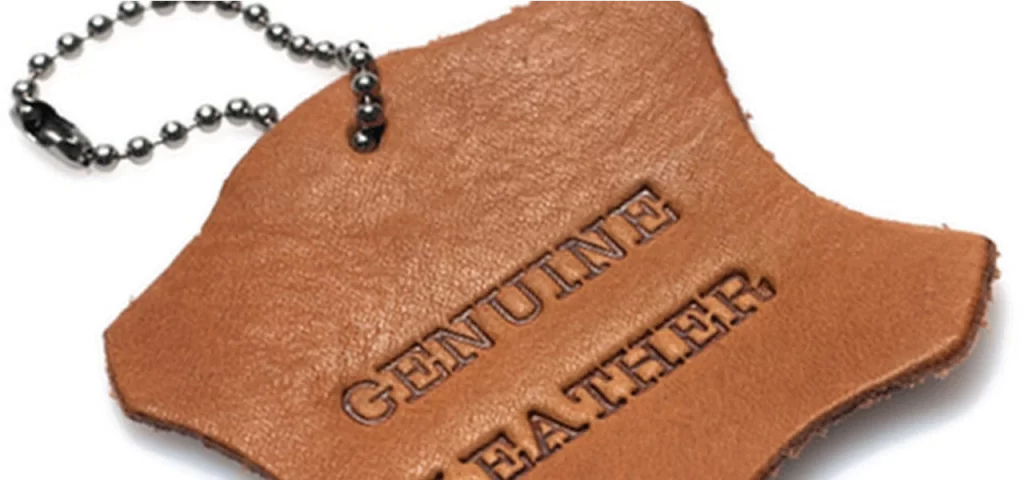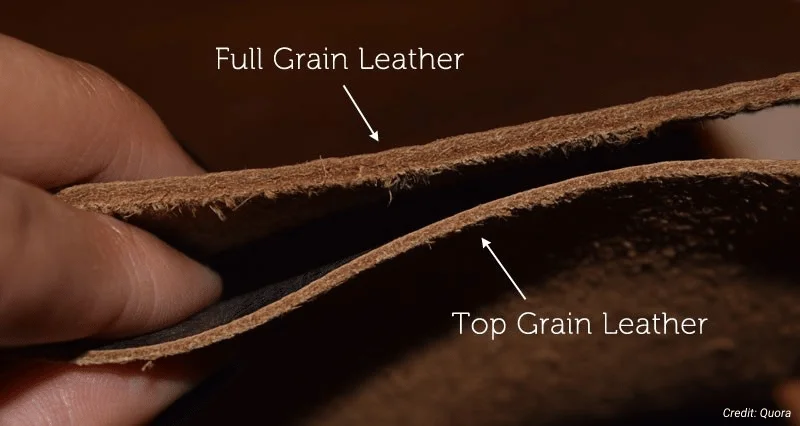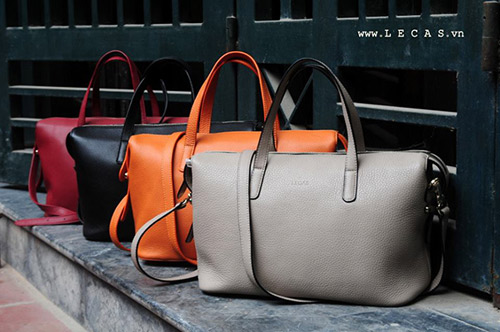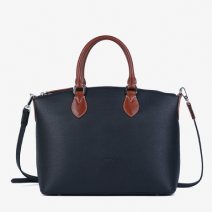In the world of leather goods, navigating the various types can be a challenge. For those seeking the pinnacle of quality and durability, full grain leather reigns supreme. But how to identify full grain leather and distinguish it from its counterparts? This guide will equip you with the knowledge to confidently spot this luxurious material.
Understanding Leather Grades: A Hierarchy of Quality
Leather goes through a tanning process that alters its structure. This processing results in various grades, each with its own characteristics. Here’s a breakdown of the key types:
Full Grain Leather
As a leather goods manufacturer, we understand the importance of using premium materials. Full grain leather stands out for its unmatched quality and durability. Unlike other leathers that undergo sanding or buffing to remove imperfections, full grain retains its natural surface, including variations in texture and markings. This results in a beautiful, unique appearance that only improves with age, developing a rich patina over time. Full grain leather is also exceptionally strong and breathable due to its intact top layer, making it a perfect choice for long-lasting and luxurious leather goods.
Top Grain Leather
In the world of wholesale leather goods, top grain leather offers a compelling blend of quality and affordability. Crafted from the topmost layer of the hide, it boasts a smooth, consistent surface thanks to a light sanding process. This removes minor imperfections while preserving the natural grain pattern, creating a visually appealing and uniform aesthetic. While not quite as durable as full grain leather due to the removal of some surface fibers, top grain leather remains exceptionally strong and resistant to wear and tear. It’s also typically treated with a protective finish, enhancing its stain resistance and making it easier to maintain, a valuable benefit for a wide range of wholesale leather goods applications.
Genuine Leather
Within the realm of genuine leather goods manufacturers, the term “genuine leather” encompasses a broad category. Unlike full grain or top grain leather, which come from specific layers of the hide, genuine leather can utilize various cuts and layers. This often results in a more affordable price point for wholesale leather goods. However, the quality can vary depending on the source and processing techniques. Genuine leather may have a corrected grain surface or contain imperfections, but it still offers inherent advantages over synthetic materials. It provides a natural look and feel, breathability, and a degree of durability, making it a suitable choice for a variety of applications in the world of genuine leather goods.

Read more The Essence of Genuine Leather Goods Manufacturers
Read more LECAS’s Materials
How to Identify Full Grain Leather?
Now, let’s delve into the specific characteristics that will help you answer the question: how to identify full grain leather?

Natural Imperfections: Full grain leather retains its natural markings, like scars, wrinkles, and insect bites. These imperfections are not flaws but rather hallmarks of authenticity.
Uneven Surface Texture: Unlike sanded leathers, full grain has a slightly uneven and natural texture. You might feel a slight graininess when running your fingers across the surface.
Richer Color and Ability to Develop Patina: Full grain leather absorbs dyes deeply, resulting in richer and more vibrant colors. Over time, it develops a beautiful patina, a polished and burnished look that enhances its character.
Stiffness and Suppleness: Full grain leather might initially feel stiffer than other grades. However, with use, it softens and develops a comfortable suppleness that retains its shape.
Why Choose Full Grain Leather
For centuries, leather has been a coveted material, prized for its strength, beauty, and natural feel. But within the world of leather, there exists a hierarchy, with full grain leather reigning supreme. Leather goods manufacturers understand this distinction, and for good reason. Here’s why full grain leather stands out:
- Unmatched Durability: Unlike other leathers that undergo sanding or buffing to remove imperfections, full grain retains its natural top layer, the most robust part of the hide. This translates to exceptional tear and wear resistance, ensuring leather goods crafted from full grain can withstand years of use and even become cherished heirlooms.
- Timeless Beauty with Age: Full grain leather embraces its natural imperfections – wrinkles, scars, and variations in texture. These imperfections, often seen as flaws in other leathers, become hallmarks of authenticity in full grain. Over time, these imperfections develop a rich patina, a unique and beautiful characteristic that adds depth and character to the leather. This aging process creates a truly one-of-a-kind piece that tells a story.
- Superior Breathability: Full grain leather’s intact top layer allows for natural breathability. This is particularly beneficial for items like wallets, bags, and shoes, as it prevents moisture build-up and provides a more comfortable user experience.
- Luxurious Feel: The natural grain and subtle variations in texture create a rich, luxurious feel that is unmatched by other leather grades. This elevates the overall quality and value perception of leather goods, making them stand out in a crowded marketplace.
- Investment Value: Full grain leather goods are considered an investment. Their exceptional durability and timeless appeal often lead to an increase in value over time. This makes them a wise choice for manufacturers seeking to create premium products that resonate with discerning customers.
How to Identify Full Grain Leather: So, you’ve learned about the many benefits of full grain leather, but how can you tell if a leather product is truly full grain? Here are some key things to look for:
- Visual Inspection: Full grain leather exhibits natural imperfections like wrinkles, scars, or bug bites. The grain pattern will also be pronounced and individual, not perfectly uniform.
- Touch: It should feel supple and smooth, yet firm and substantial, not overly soft or flimsy.
- Weight: Due to its density, full grain leather is generally heavier than other leather grades.
The Best Applications for Full Grain Leather Goods Manufacturing
Wallets and Bags
Wallets, handbags, briefcases, and backpacks crafted from full grain leather can withstand daily wear and tear, scratches, and abrasions. Over time, they develop a beautiful patina, transforming into treasured companions that tell the story of their journeys.

Belts and Watch Straps
Full grain leather belts endure years of use without losing shape or showing signs of wear. Similarly, full grain watch straps offer a touch of luxury and timeless elegance that complements any watch style.
Choosing full grain leather signifies a commitment to superior craftsmanship and lasting value. While the cost might be slightly higher, these products offer unmatched durability, develop a unique aesthetic with age, and provide a luxurious user experience. For discerning manufacturers seeking to create timeless pieces and cater to customers who appreciate quality, full grain leather is the perfect choice. Contact LECAS to customize your full grain leather goods now!





BLOG
Maybe You Are Interested
Exploring the Inner Workings of a Leather Bag Factory
Ever wondered how your favorite leather bag is made? In this article LECAS Leather will...
Choosing the Best Leather Wallet Manufacturer: A Comprehensive Guide
Picking the best leather wallet manufacturer is super important if you want a wallet that...
Top Vegan Leather Manufacturers Paving the Way for Sustainable Fashion
With the world becoming more eco-friendly, the fashion industry is also making changes. Vegan leather...
Top Trends Among Leather Wallet Manufacturers
In 2024, leather wallet manufacturers are embracing new trends that blend style with functionality. From...
Top Trends From the Leading Manufacturer of Leather Products in 2024
In 2024, the leather goods industry is buzzing with new trends. The leading manufacturer of...
The Future of Manufacturing Leather Products: Trends and Innovations
The leather manufacturing industry is rapidly evolving, blending old techniques with new technologies. This shift...